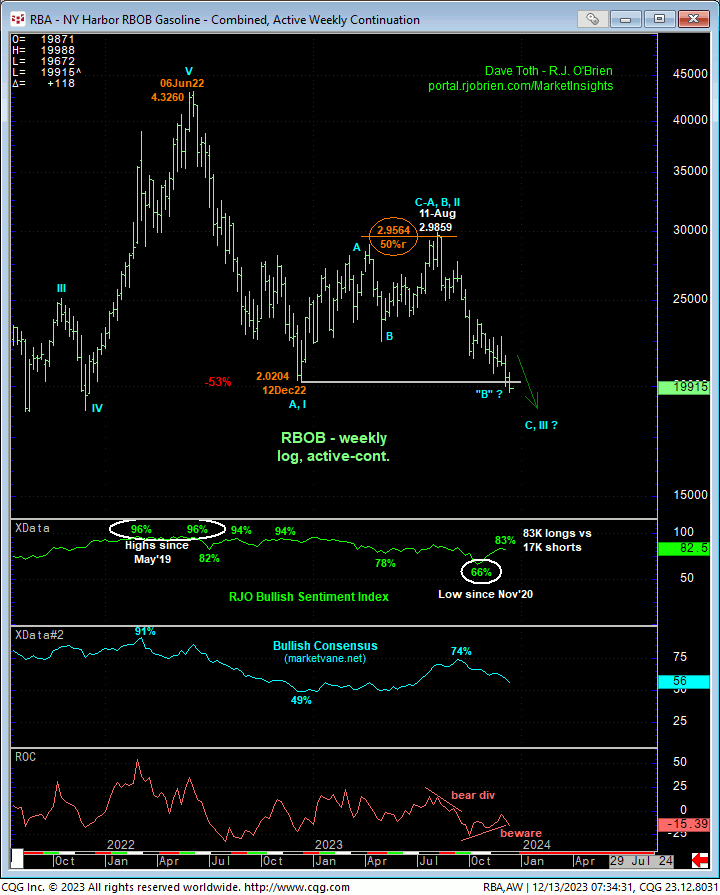
Posted on Dec 13, 2023, 08:16 by Dave Toth
JAN CRUDE OIL
Yesterday’s break below last week’s 68.80 low reaffirms our bearish count discussed in 01-Dec’s Technical Blog with the important by-product being the market’s definition of yesterday’s 71.96 high as the latest smaller-degree corrective high this market is now minimally required to recoup to break at least the portion of the downtrend from 30-Nov’s 79.60 larger-degree corrective high, let alone threaten the major downtrend from 28-Sep’s 95.03 high. Per such, we’re defining 71.96 as our new short-term but relatively key parameter from which traders can objectively rebase and manage the risk of a still-advised bearish policy and exposure.
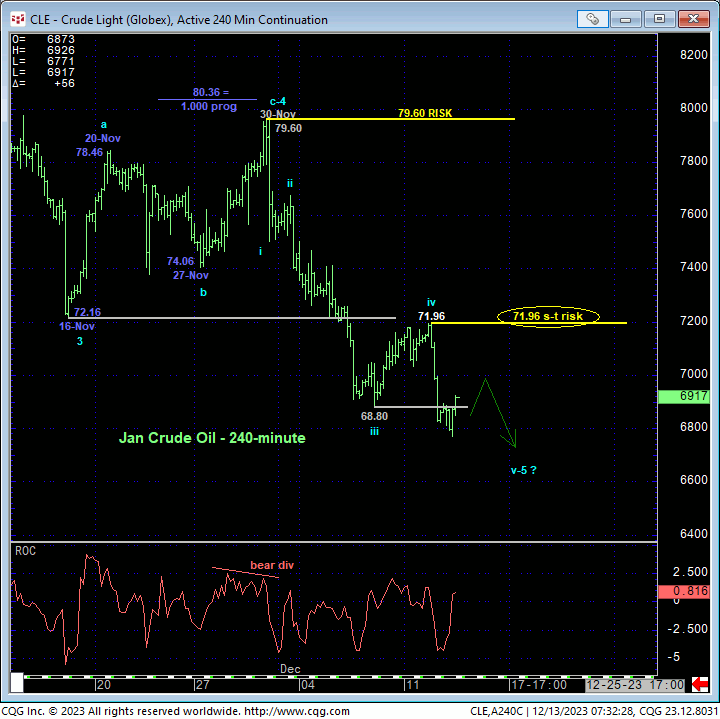
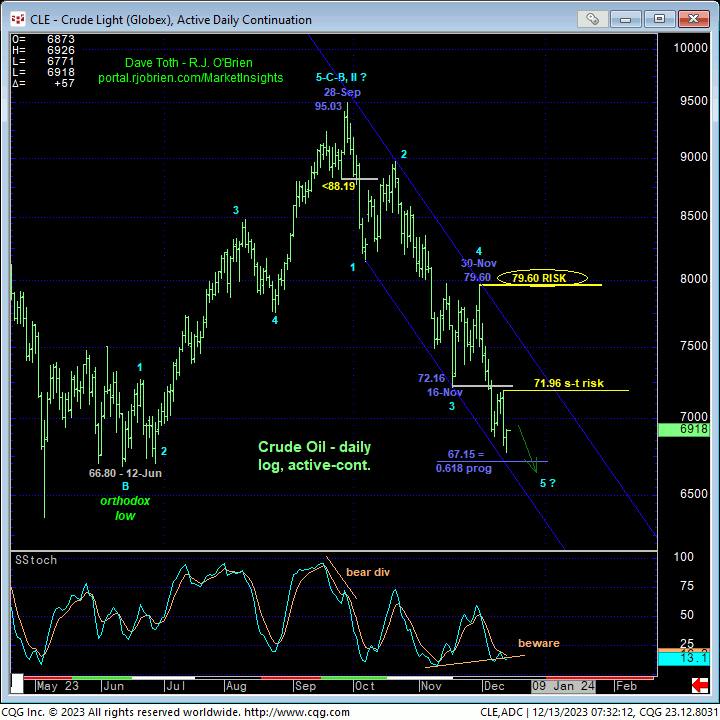
This admittedly tight, shorter0-term bear risk parameter may prove to be relatively “key” given:
- the prospect that the decline from 30-Nov’s 79.60 high might be the completing 5th-Wave of the sequence down from 28-Sep’s 95.03 high as labeled in the daily log chart above,
- the market’s engagement of the extreme lower recesses and lower-quarter of the past YEAR’S range shown in the weekly chart below, amidst
- the return to historically low levels (63%) in our RJO Bullish Sentiment Index of the hot Managed Money positions reportable to the CFTC.
NONE of these elements mean a thing until/unless the market breaks, or at least compromises the clear and present and simple downtrend pattern of lower lows and lower highs.
To break the nearly-three-month plunge from 28-Sep’s 95.03 high, commensurately larger-degree strength above 300-Nov’s 79.60 larger-degree corrective high remains obviously required. For SCALE reasons, we cannot conclude a larger-degree recovery from proof of only short-term strength above 71.96. This said, every larger-degree momentum failure begins with a smaller-degree divergence, and herein lies the importance of yesterday’s 71.96 smaller-degree corrective high and new short-term bear risk parameter.
Until and unless such minimum 71.96+ strength is confirmed and acknowledging Mar-Sep’s recovery from 64.36 to 95.03 as a 3-wave and thus corrective structure, there is no way to know that the decline from 95.03 isn’t the resumption of Jun’22 – Mar’23’s initial A- or 1st-Wave of the new secular bear market to eventual new lows below 64.36. We’ve already seen the resumption of such a secular bear trend in RBOB below Dec’22’s 2.0204 low over the past week. Similar weakness in crude oil should hardly come as a surprise.
These issues considered, a bearish policy and exposure remain advised with a recovery above 71.96 required for shorter-term traders to neutralize exposure and for even longer-term commercial players to pare exposure to more conservative levels. Until and unless such minimum strength is confirmed, further and possibly steep losses remain expected, including a resumption of last year’s major bear trend to new lows below 64.36.
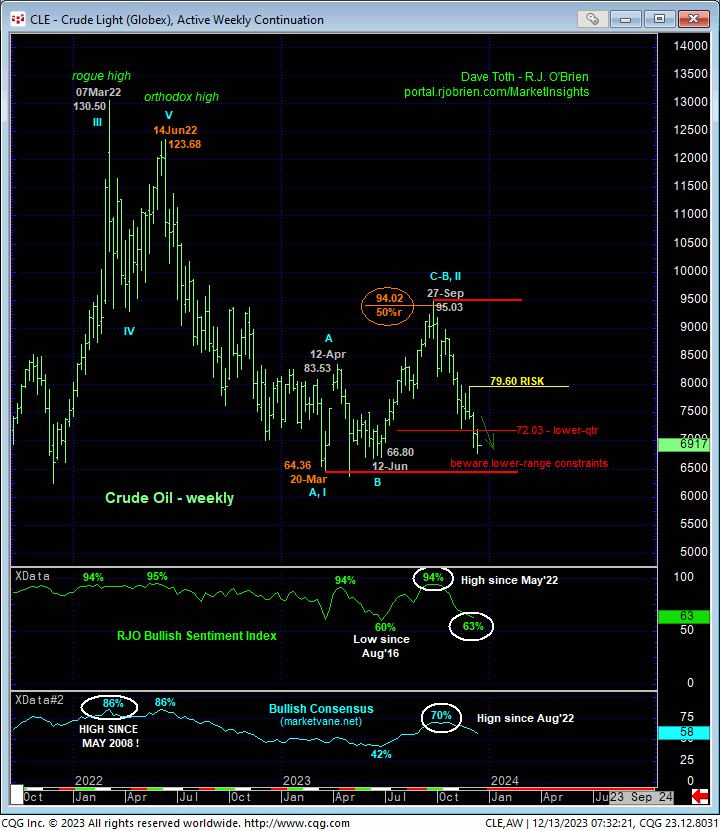
JAN HEATING OIL
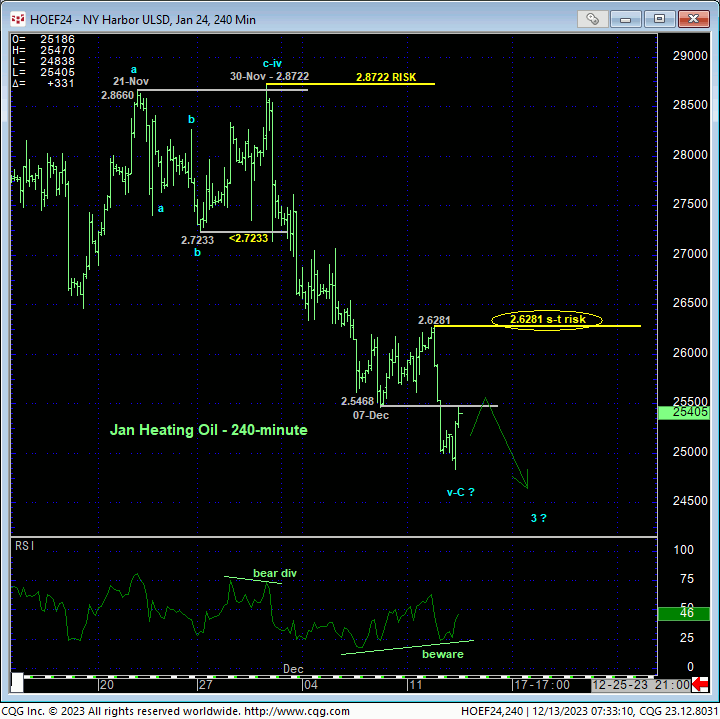
The technical construct and expectations in heating oil are identical to those detailed above in crude oil following yesterday’s break below last week’s 2.5468 low that identifies yesterday’s 2.6281 high as the latest smaller-degree corrective high and new short-term parameter from which the risk of a still-advised bearish policy and exposure can be objectively rebased and managed. 30-Nov’s 2.8722 larger-degree corrective high remains intact as our key long-term bear risk parameter pertinent to longer-term commercial players as such commensurately larger-degree strength remains required to break the major downtrend from 14-Sep’s 3.5092 high.
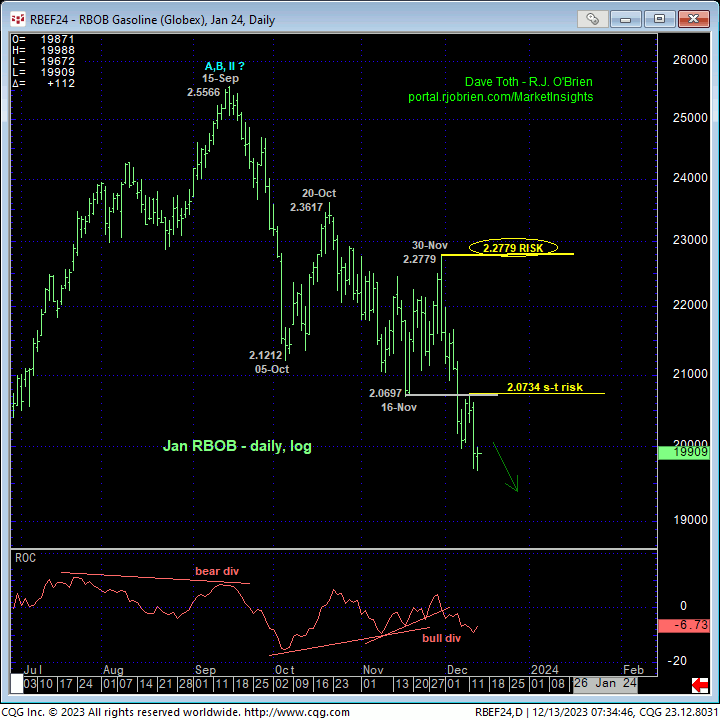
Still-frothy levels in our RJO Bullish Sentiment Index show the Managed Money community still skewed to the bull side. The extent of this skew remains a key bearish element as fuel for downside vulnerability as the overall market forces the capitulation of this long-&-wrong exposure.
In sum, a bearish policy and exposure remain advised with a recovery above 2.6281 required for shorter-term traders to neutralize exposure and for even longer-term commercial players to pare exposure to more conservative levels. In lieu of such strength, further and possibly accelerated losses should not surprise.
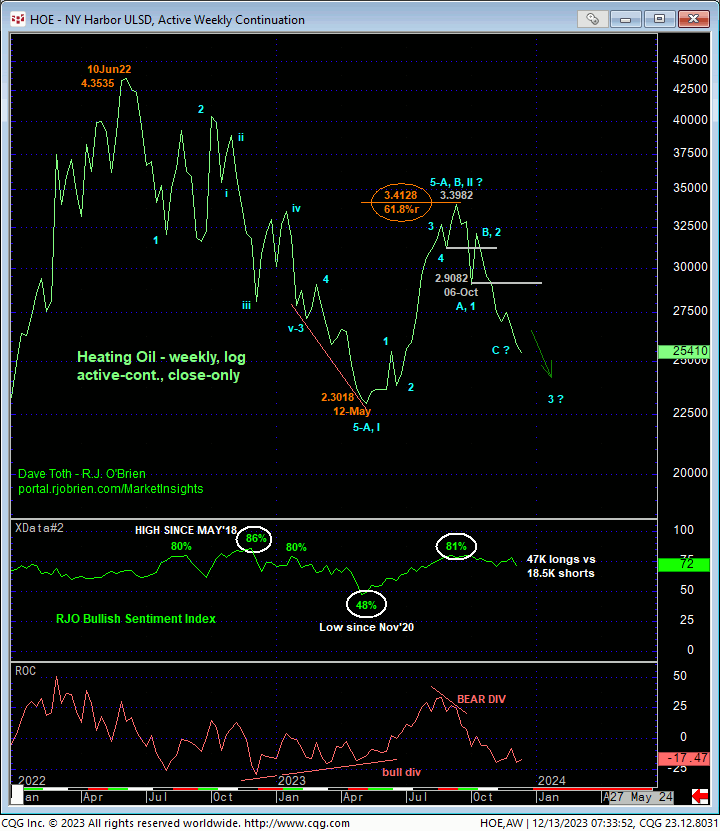
JAN RBOB
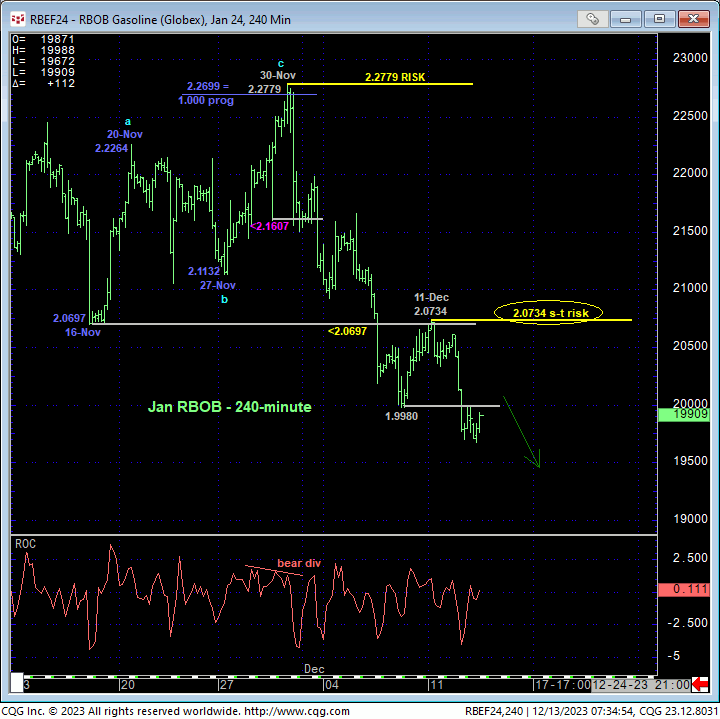
Similarly, yesterday’s RBOB break below last week’s 1.9980 low leaves Mon’s 2.0734 high in its wake as the latest smaller-degree corrective high this market is now minimally required to recoup to even defer, let alone threaten a trend that is now down on EVERY scale following last week’s break below Dec’22’s 2.0204 low that has held as support for nearly a YEAR. Per such, 2.0734 is considered our new short-term parameter from which traders can objectively rebase and manage the risk of a still-advised bearish policy and exposure.
Both the 240-min chart (above) and daily log chart (below) of the Jan contract also show former 2.0700-area support as new near-term resistance following last week’s breakdown below 16-Nov’s 2.0697 low.
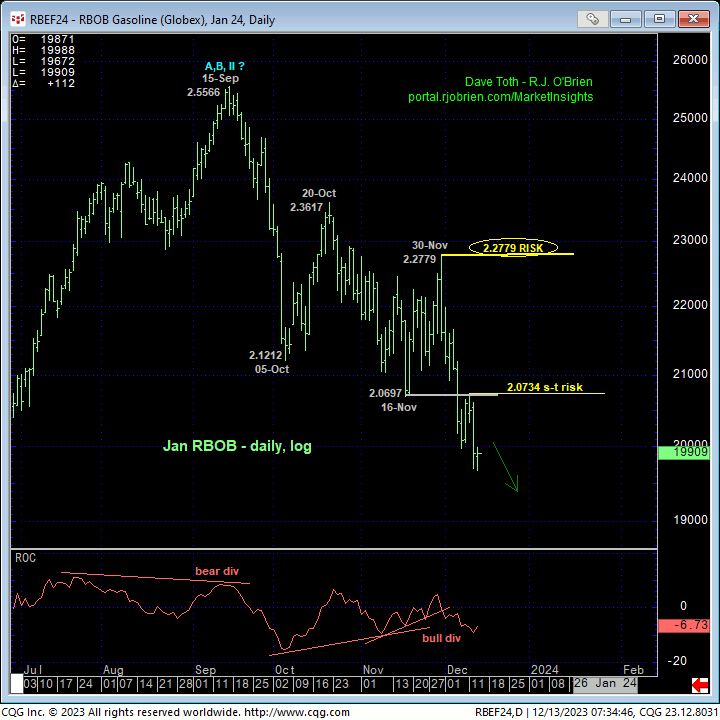
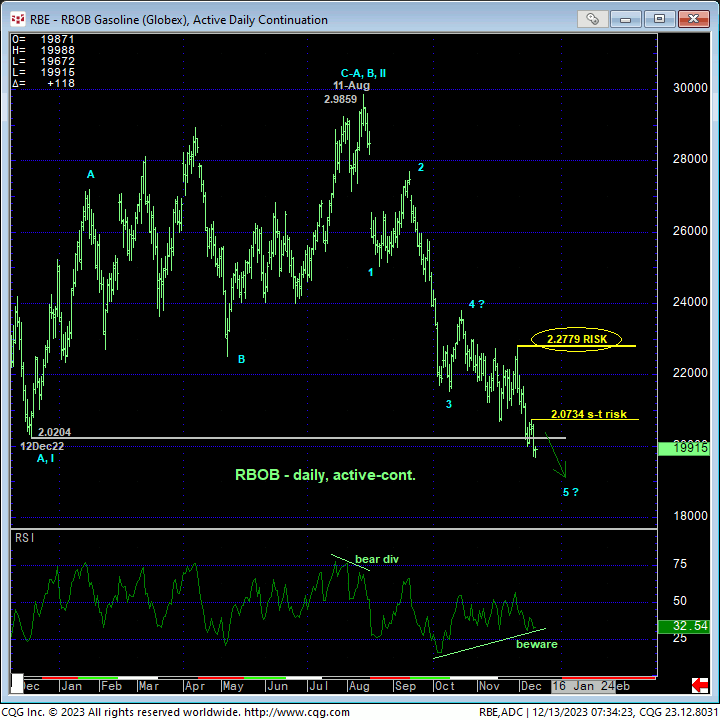
On an active-continuation basis, the daily chart above and weekly log chart below show last week’s break below Dec’22’s 2.0204 low that reinstates 2022’s start to a new secular bear trend. The market’s downside potential is considered indeterminable and potentially sever with the ONLY levels of any technical merit now only ABOVE the market in the form of prior corrective highs like 2.0734 and 30-MNov’s 2.2779 larger-degree corrective high.
Also worthy of note is that DESPITE and in the direct face of the past four months’ downtrend and resumption of what is the continuation of a massive, multi-quarter peak/reversal process, our RJO Bullish Sentiment Index still shows the Managed Money community with a sharp BULLISH skew to their positions reportable to the CFTC. The extent of this long-&-wrong exposure is considered major fuel for downside vulnerability if the overall market forces its capitulation of this increasingly costly position.
These issues considered, a bearish policy and exposure remain advised with a recovery above 2.0734 required for traders to pare or neutralize exposure and circumvent the heights unknown of a steeper correction or a reversion to the middle-half bowels of the past year’s range. Until and unless such strength is shown, the trend is down on all scales and should not surprise by its continuance or acceleration straight away.
